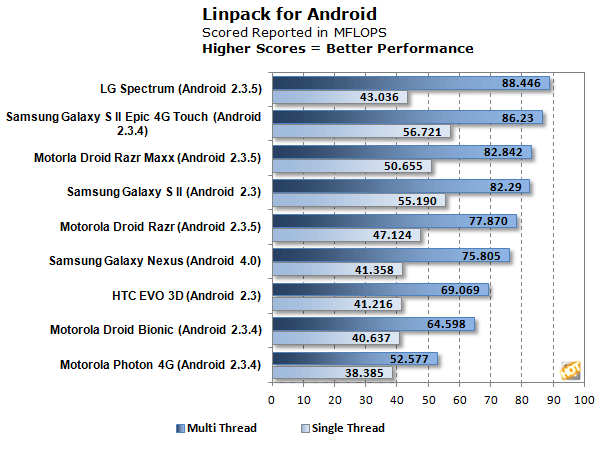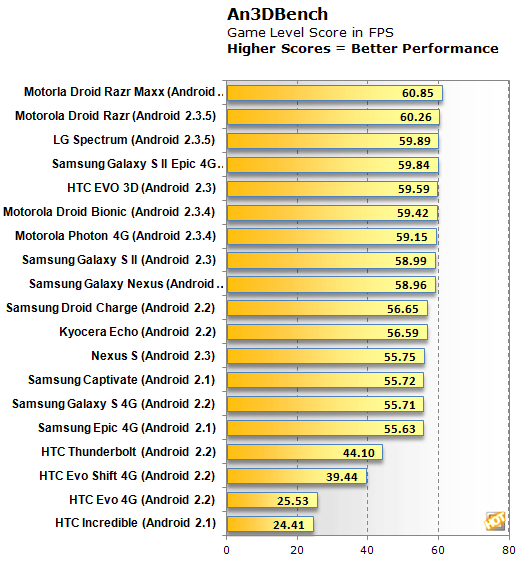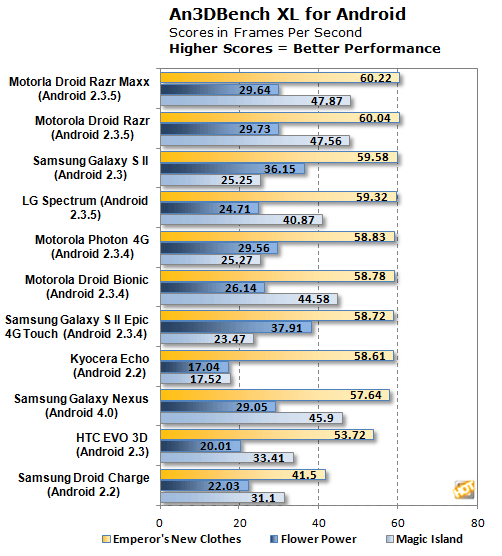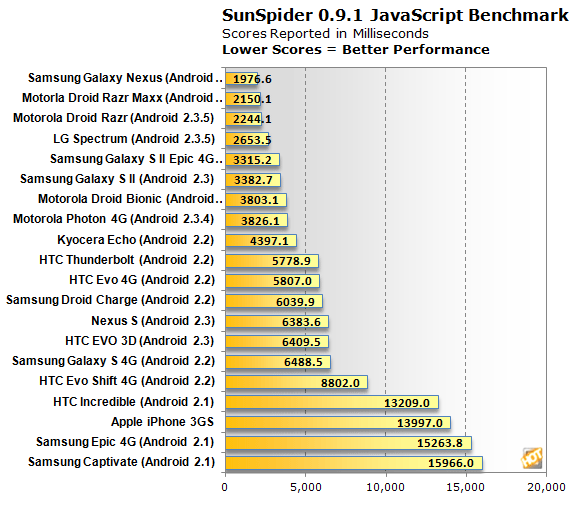Not long ago, Motorola and Verizon Wireless brought back the popular Razr line of cell phones in the form of the all new Droid Razr. Now, the two companies are teaming up again to offer another new Razr known as the Razr Maxx. Although these two Droid Razr smartphones are alike in many ways, there are also a few key differences.
The most notable of these differences is battery life. The Droid Razr Maxx claims to offer the longest talk time of any 4G smartphone. Motorola says the Razr Maxx will last for 21 hours of talk time, 7 straight hours of web browsing, 15 hours of movie watching, and two and a half days of music playback. By comparison, the original Droid Razr smartphone claims to offer a battery life of up to 12.5 hours of continuous talk time.
Because it has a larger battery, the Razr Maxx isn't as thin as the original Razr (7.1mm thick), but it's still relatively thin. In fact, the Razr Maxx measures just 8.99mm thick. The Razr Maxx also offers the same durability features as the original Droid Razr, including KEVLAR fiber, Corning Gorilla Glass, and water-resistance.
When we reviewed the Droid Razr, Verizon Wireless had the 32GB version of the phone priced at $299.99. Since then, the wireless carrier has dropped that price by $50 to $249.99. Since the Droid Razr Maxx is currently available for $299.99 with a contract and compatible plan, its obvious the price drop on the original Droid Razr is an effort to help differentiate the two Razr phones. The Razr Maxx comes with 32GB of storage (16GB onboard and 16GB microSD).
With all of the great smartphones on the market today, we know what you're wondering: Is the thicker and slightly more expensive Droid Razr Maxx a better alternative to the first Droid Razr and other smartphones available today? We'll seek to answer this question and many others in our full hands-on review. But first, a short video of the Maxx in action...
|
| Network | Verizon Wireless |
| Bands/Modes | CDMA800, CDMA1900, LTE B13 700 |
| OS | Android 2.3.5 (Gingerbread) will be upgradeable to Android 4.0 (Ice Cream Sandwich) |
| Display | 4.3-inch Super AMOLED Advanced qHD (540 x 960) scratch-resistant Corning Gorilla Glass |
| Processor | Dual core 1.2 GHz processor |
| Memory | 1 GB of LP DDR2 RAM 16 GB internal memory 16 GB microSD card pre-installed, supports up to 32 GB microSD |
| Talk and Standby Time | Talk Time (Continuous): up to 21.5 hours or Standby Time: up to 15.8 days |
| Dimensions | 5.15 x 2.71 x 0.35 inches |
| Weight | 5.1 ounces |
| Battery | 3300mAH Li Ion |
| Connectivity | Bluetooth, 802.11 b/g/n, Mobile Hotspot, microUSB, micro HDMI, DLNA 1.5, aGPS, 3.5mm headset jack, |
| Camera | 8 MP rear facing camera with LED flash 1.3 MP front facing camera with 720p HD video capture |
| Other key features | Made with KEVLAR fiber and scratch-resistant Corning Gorilla Glass Webtop enabled |
| Price | $299.99 with contract and discounts |
The Droid Razr Maxx looks like a slightly beefier version of its older brother, the Droid Razr. In fact, a head-on shot makes the two phones look pretty much identical. If you were to hold the two phones side-by-side, however, you'd quickly notice the difference in thickness and weight between these two smartphones.
The Droid Razr Maxx measures 0.35 inches thick while the Droid Razr measures 0.28 inches thick. In addition, the Droid Razr Maxx weighs a bit more than its brother (5.1 ounces versus 4.48 ounces). With its slightly heavier form, the Droid Razr Maxx has a mid-range weight compared to other phones available today.
| Samsung Galaxy S 4G | 4.2 ounces |
| Motorola Droid Razr | 4.48 ounces |
| Nexus S | 4.55 ounces |
| Samsung Galaxy SII Epic 4G Touch | 4.6 ounces |
| HTC Droid Incredible | 4.6 ounces |
| Apple iPhone 4 | 4.8 ounces |
| Apple iPhone 4S | 4.9 ounces |
| Samsung Droid Charge | 5.04 ounces |
| Motorola Droid Razr Maxx | 5.1 ounces |
| Motorola Droid Bionic | 5.57 ounces |
| Motorola Photon 4G | 5.6 ounces |
| HTC EVO 3D | 6 ounces |
| HTC Thunderbolt | 6.23 ounces |
The Droid Razr Maxx and the Droid Razr feature the same 4.3-inch Super AMOLED Advanced qHD (540 x 960) display with scratch-resistant Corning Gorilla Glass. Just as we liked the Super AMOLED display on the Droid Razr, we have found the Droid Razr Maxx's screen to be colorful, vibrant, and have excellent viewing angles.
As far as the placement of hardware ports and keys, the Droid Razr Maxx and the Droid Razr have an identical configuration. Below the Droid Razr Maxx's 4.3-inch qHD display, you'll find four traditional touch sensitive backlit buttons (Menu, Home, Back, and Search). The front-facing webcam is at the top of the phone just below the A in the Motorola logo.
Like the Droid Razr, the Droid Razr Maxx has a thicker area on the back of the device near the top. The difference between the thin and thick points on the Droid Razr Maxx isn't as pronounced as on the Droid Razr, but it's still evident. You'll find the 8MP camera and flash as well as the microUSB port, micro HDMI port, and headset jack in this thicker area on the back and top of the Droid Razr Maxx.
Also like the Droid Razr, the Droid Razr Maxx has a door on the left side of the phone that opens to reveal the Micro-SIM card slot and microSD slot. The right edge of the phone houses a power button and volume rocker. The back of the phone has the same soft finish and zigzag pattern as found on the Droid Razr.
One of our complaints about the Droid Razr was that it lacked a removable back plate as well as a removable battery. Unfortunately, Motorola didn't change this design with the Droid Razr Maxx; this new version of the phone may solve some people's concerns by offering a longer battery life, but it still lacks a user-replaceable battery which is a feature we miss on any phone regardless of battery capacity.
n addition to using the Motorola Droid Razr Maxx in a variety of everyday usage scenarios, we also conducted some formal performance testing to see how well the Droid Razr Maxx compares to other smartphones.
|

|


|

In the Linpack test, the Droid Razr Maxx outscored the original Droid Razr and posted pretty high scores in both the single- and multi-threaded tests. Overall, the Droid Razr Maxx ranked third.
In the An3DBench, the Droid Razr Maxx edged out the Droid Razr to earn the top score. In the An3DBench XL test, the Droid Razr Maxx also earned the top spot in the Emperor's New Clothes test. It also fared exceptionally well in the Magic Island test, earning first place. With the Flower Power test, the Droid Razr did well, but came in just behind a handful of devices including the original Droid Razr.
The Droid Razr Maxx also performed very well in the SunSpider JavaScript benchmark, earning second place behind the Samsung Galaxy Nexus.

Tidak ada komentar:
Posting Komentar